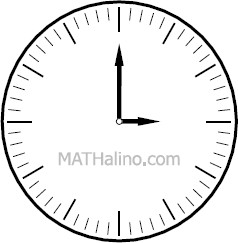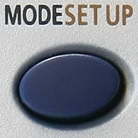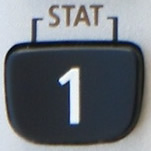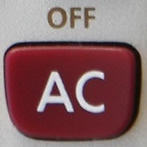The following models of CASIO calculator may work with these methods: fx-570ES, fx-570ES Plus, fx-115ES, fx-115ES Plus, fx-991ES, and fx-991ES Plus.
Before we go to Calculator technique, let us first understand the movements of the hands of our continuously driven clock.
 For simplicity, let "dial" be the unit of one hand movement and there are 60 dials in the complete circle as shown in the figure.
For simplicity, let "dial" be the unit of one hand movement and there are 60 dials in the complete circle as shown in the figure.
- When the minute-hand moves 60 dials, the hour hand moves 5 dials. The ratio of the two movements, hour-hand over minute-hand, is 5/60 = 1/12. Thus, if the minute-hand will move x-minutes, the hour-hand moves by x/12 minutes.
- When the second-hand moves 60 dials, the minute-hand moves 1 dial. The ratio of the two movements, minute-hand over second-hand, is 1/60. Thus, if the second-hand will move x-seconds, the minute-hand moves by x/60 seconds, and the hour-hand also moves by 1/12 of x/60 or x/720 seconds.
- The relationship of hand-movements can also be translated in terms of degree unit which I found handy in calculator technique for board exam problems. We know that a complete circle is equal to 360° and equal to 60 dials. Thus, 1 dial is equivalent to 360°/60 = 6° and five dials is equivalent to 5(6°) = 30°. Note that 1 dial move of the minute-hand is equivalent to 1 minute of time, and five dials move of the hour-hand is equivalent to 1 hour of time.
Knowing all of the above, we can now develop the calculator technique for solving clock-related problem. We will solve some example here in order to apply this time saving technique.
Problem
What time after 3:00 o'clock will the minute-hand and the hour-hand of the clock be (a) together for the first time, (b) perpendicular for the first time, and (c) in straight line for the first time?
Traditional Solution
Solution by Calculator
The following calculator keys will be used.
| Name |
Key |
Operation |
| Shift |
 |
SHIFT |
| Mode |
 |
MODE |
|
| Name |
Key |
Operation |
| Stat |
 |
SHIFT → 1[STAT] |
| AC |
 |
AC |
|
The relationship between the movements of the clock hands is linear. We can therefore use the Linear Regression in STAT mode.
Approach No. 1
Take 3:00 pm as reference point. Initially, the minute-hand of the clock is at 0 dial and the hour-hand of the clock is advance by 15 dials, thus, coordinates (0, 15). After 1 hour (4:00 pm), the minute-hand advanced by 60 dials leaving the hour-hand 40 dials, thus, coordinates (60, -40).
MODE → 3:STAT → 2:A+BX
(a) Together for the first time: The distance between the hands of the clock is zero. We will therefore find X when Y is zero in our table.
AC → 0 SHIFT → 1[STAT] → 7:Reg → 4:x-caret
0x-caret = 16.36
Thus, time = 3:16.36 pm
(b) Perpendicular for the first time: The hour-hand is behind by 15 dials by the minute hand. Let us find X when Y is -15.
AC → -15 SHIFT → 1[STAT] → 7:Reg → 4:x-caret
-15x-caret = 32.73
Thus, time = 3:32.73 pm
(c) Straight line for the first time: The hour-hand is behind by 30 dials by the minute hand, thus find X when Y is -30.
AC → -30 SHIFT → 1[STAT] → 7:Reg → 4:x-caret
-30x-caret = 49.09
Thus, time = 3:49.09 pm
The above approach works fine but you need to mentally visualize the hands of the clock to get the proper sign (positive or negative) and value of the coordinates. See for example if the given time is 10:00 pm, the hands will be in straight line for the first time with the hour hand advancing the minute hand by 30 dials. Thus Y is +30 and not -30. This mental visualization takes the same effort as the traditional solution; the only difference is the absence of drawing. Without the drawing is good already but we can do better than that. The next approach will be more consistent, the only catch is that you need to memorize the numbers 30 and 330. I think it is not hard to memorize that numbers.
Approach No. 2
In the first approach, both X and Y are in dial units. In this second approach, the X coordinate will be in dial and Y coordinates in degrees. Recall that in 1 hour, the hour-hand will move 5 dials equivalent to 30° and the minute-hand moves for 60 dials or 360°. The 1 hour difference is therefore 360° - 30° = 330° for the hour and minute-hands of the clock. At 3:00 pm, the minute-hand is at -90° in reference with the hour-hand, thus coordinates (0, -90). After 1 hour, that is at 4:00 pm, the minute hand advanced the right hand by 330° - 90° = 240°, thus coordinates (60, 240)
MODE → 3:STAT → 2:A+BX
| X |
Y |
Explanation |
| 0 |
-90 |
← -3 × 30 |
| 60 |
240 |
← 330 - 90 |
(a) Together for the first time: The angle between the hands of the clock is zero. Find X when Y is zero in our table.
AC → 0 SHIFT → 1[STAT] → 7:Reg → 4:x-caret
0x-caret = 16.36
Thus, time = 3:16.36 pm
(b) Perpendicular for the first time: The angle between the hour-hand and minute-hand is 90°. Let us find X when Y is 90.
AC → 90 SHIFT → 1[STAT] → 7:Reg → 4:x-caret
90x-caret = 32.73
Thus, time = 3:32.73 pm
(c) Straight line for the first time: The angle between the hour-hand and minute-hand is 180°, thus find X when Y is 180.
AC → 180 SHIFT → 1[STAT] → 7:Reg → 4:x-caret
180x-caret = 49.09
Thus, time = 3:49.09 pm
For me, the second approach is more rapid and easy to implement. I recommend you master just one and be good at it.
Problem
How soon after 5:00 o'clock will the hands of the clock form a (a) 60-degree angle for the first time, (b) 60-degree angle for the second time, and (c) 150-degree angle?
Solution by Calculator Technique
MODE → 3:STAT → 2:A+BX
| X |
Y |
Explanation |
| 0 |
-150 |
← -5 × 30 |
| 60 |
180 |
← 330 - 150 |
(a) 60-degree angle for the first time
AC → -60 SHIFT → 1[STAT] → 7:Reg → 4:x-caret
-60x-caret = 16.36 minutes answer
(b) 60-degree angle for the second time
AC → 60 SHIFT → 1[STAT] → 7:Reg → 4:x-caret
60x-caret = 38.18 minutes answer
(c) 150-degree angle
AC → 150 SHIFT → 1[STAT] → 7:Reg → 4:x-caret
150x-caret = 54.54 minutes answer
You may also like the calculator technique for arithmetic progression, geometric progression, and harmonic progression.
 MATHalinoEngineering Math Review
MATHalinoEngineering Math Review Blog posts (unless otherwise specified) licensed under a Creative Commons Licence.
Blog posts (unless otherwise specified) licensed under a Creative Commons Licence.
「save」
「save」